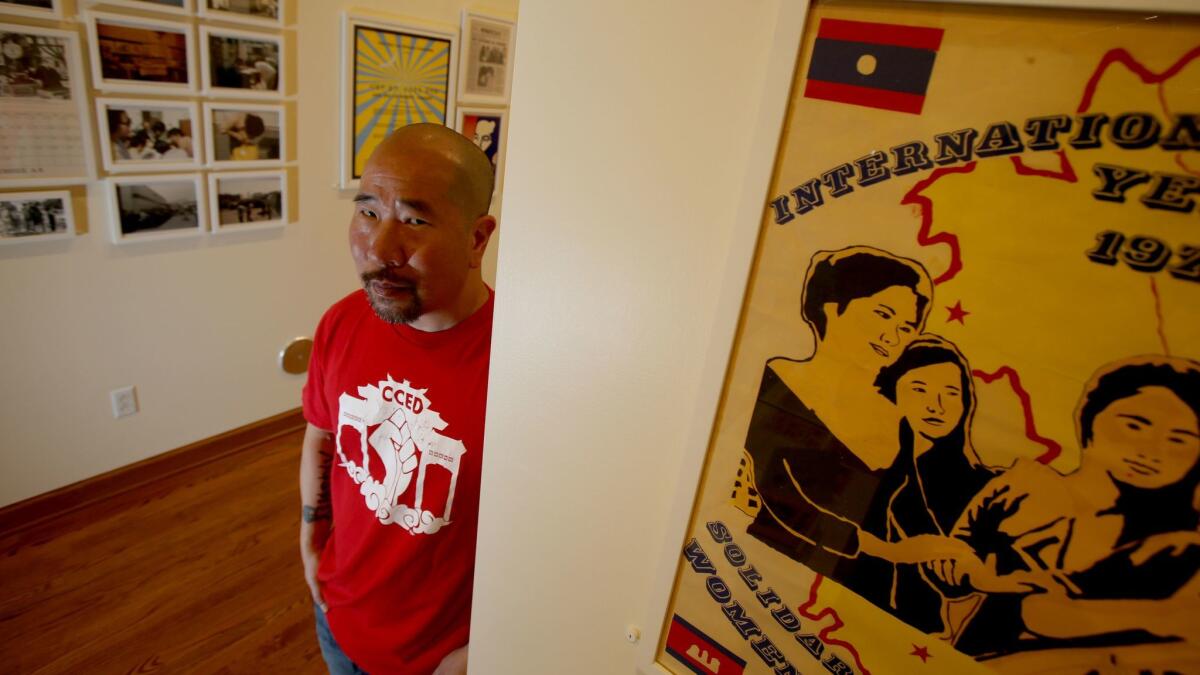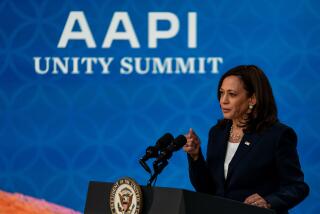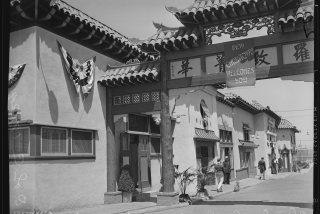Before Asian Americans could be ‘woke,’ they had to shed the ‘Oriental’ label

Frances Huynh, 24, grew up in El Monte among a community of Chinese, Vietnamese and Mexican immigrants where being Asian American was something she knew rather than asserted.
But in college, she began to read about Asian American history and met other activists. After graduating, she volunteered in Chinatown. Her identity became less of a label and more of a statement.
For the record:
11:05 a.m. Jan. 26, 2017An earlier version of this article had the wrong age for Frances Huynh. She is 24.
“Being Asian became more of a political commitment,” said Huynh, now a community organizer in Chinatown.
“Roots,” a new exhibition at the Chinese American Museum, argues that Asian American identity has always been political. It chronicles the Asian American movement, a spontaneous, nationwide mobilization of young people during the 1960s and ’70s that supported the civil rights movement, rejected “Oriental” stereotypes and popularized a pan-Asian racial identity.
It was important to ... show that we can learn from the past to fight today’s battles.
— Steve Wong, chief curator at Los Angeles’ Chinese American Museum
It’s a story that hasn’t been told much, said the exhibition’s curator, Ryan Lee Wong. Few Asian Americans today, he says, know that Filipino farm workers sat at Cesar Chavez’s negotiating table or that Little Tokyo’s Amerasia bookstore fomented discourse between activists in different cities, stocking radical newspapers like Gidra, a lushly illustrated, sharp-tongued newspaper founded at UCLA.
In 1969, the newspaper even provided a definition for “woke,” a term activists often use to describe people who believe that systemic racism permeates virtually every aspect of life in America, causing widespread social injustice.
“This is a new role for the Asian American,” wrote Larry Kubota in an article titled “Yellow Power.” “It is the rejection of the passive Oriental stereotype and symbolizes the birth of a new Asian — one who will recognize and deal with injustices.”
The exhibition opened one day before President Trump’s inauguration, which spurred millions of people across the nation to protest.
Steve Wong, chief curator at the museum, hopes the exhibition gets young activists talking to older ones.
“It was important to make it relevant to a younger generation and show that we can learn from the past to fight today’s battles,” he said.
With that in mind, the museum commissioned a zine with works by young Asian American artists and activists to accompany the exhibition. The exhibition also encourages visitors to wrestle with the “model minority” stereotype of Asians as uniformly well-educated and wealthy.
Through photographs, protest literature and art, the exhibition depicts Asian Americans’ formative steps to shed the “Oriental” label and choose their own American identity. It tells the story of Asian Americans forming civil rights organizations at UCLA, UC Berkeley and other colleges, while gradually becoming aware of one another through newspapers, protests and conventions.
I used to shy away from that part of me — looking, feeling and being Asian — but that was driven by insecurity.
— Jonathan Park, a Koreatown rapper known as Dumbfoundead
The curators hope to connect the range of social and political issues today’s activists are engaged in with those of the ’60s and ’70s, when tenants’ rights, political prisoners, the normalization of relations with China and medical relief for survivors of the World War II bombings of Japan were on Asian activists’ agendas.
On the exhibition’s opening night last week, about 500 people attended — so many that long lines to enter the gallery snaked around the museum’s interior. Many were young Asian Americans pondering questions about their identity and politicized by protests and the rise of Black Lives Matter following the fatal police shooting of an unarmed young, black suspect in Ferguson, Mo.
Among them was Koreatown rapper Dumbfoundead, a.k.a. Jonathan Park. His music has grown more political lately — a recent music video consists of scenes from Hollywood films with his face superimposed on the lead actor’s head — and identity has become a frequent subject of his rhyme writing.
“I used to shy away from that part of me — looking, feeling and being Asian — but that was driven by insecurity,” Park said. “And that has gone away lately.”
Kristin Fukushima, a 29-year-old activist and managing director of the Little Tokyo Community Council, noted many similarities between her work and the activism of the ’60s.
“We’re talking about the same things, but we have different language now,” Fukushima said.
Many young activists call cross-racial unity “allyship,” and the term “social justice” has largely supplanted “civil rights.” One generation’s support for Asian American art, music and movies of the ’60s and ’70s is echoed by modern-day protests against Hollywood filmmakers casting white actors in Asian roles.
But many things have also changed, said Karen Ishizuka, author of a recent book about the origins of the Asian American movement. The exhibition depicts an era when the Asian American population of the country was just hitting 1 million and mostly composed of Chinese, Filipino and Japanese people.
Now there are about 20 million Asian Americans in the U.S., and the demographic category of Asian American contains more variety in wealth, education and ethnicity than ever before: more recent, wealthier Chinese immigrants; Korean Americans scarred by the violence of the L.A. riots; and Hmong, Cambodian and Vietnamese refugees, among others.
Ishizuka said it often feels as if activists need to retell the story of the Asian American movement to every new generation of immigrants and their children.
On opening night, Marion Wong, a 64-year-old retired history teacher from Culver City, paused before a black and white photograph, spotting a familiar face.
“That’s me!”
Wong and her friends reminisced in front of the photo as activist Scott Oshima, 28, listened in. Wong was part of a group of UCLA students who volunteered in Chinatown in the 1970s and formed basketball and volleyball teams so that girls could have a league to play in. Wong turned to Oshima, who is a distant relative.
“Your mom played on that volleyball team,” Wong said.
“No way!” Oshima responded. “I’ll have to ask her about that.”
Twitter: @frankshyong
ALSO
At L.A.-area gun store, Chinese immigrants exercise an unfamiliar right to bear arms
‘Here, I am above average’: Chinese ‘parachute kids’ are coming to the U.S. at younger ages
Taiwan is trending, and L.A.’s Taiwanese community has mixed feelings about it
More to Read
Sign up for Essential California
The most important California stories and recommendations in your inbox every morning.
You may occasionally receive promotional content from the Los Angeles Times.











